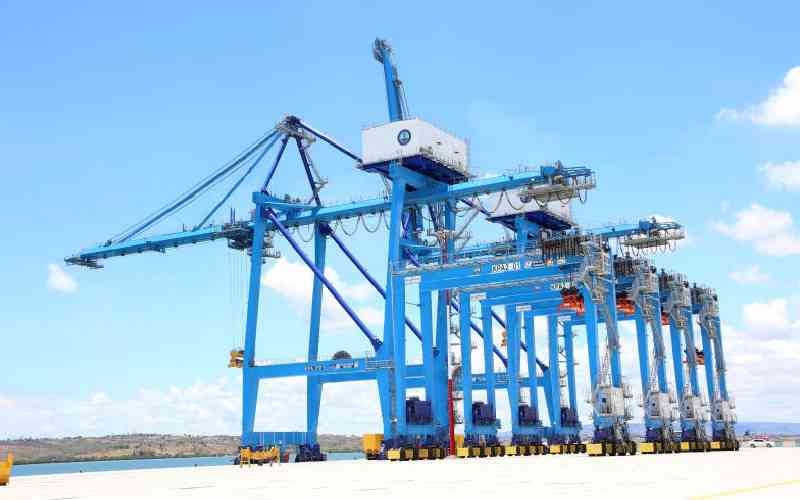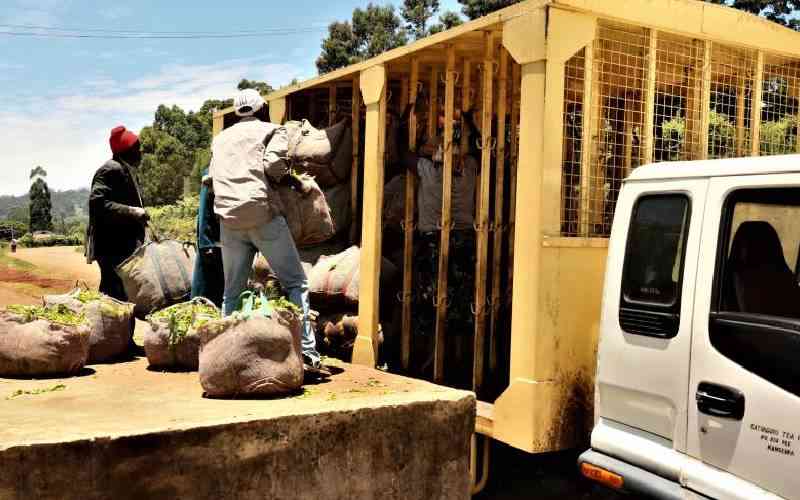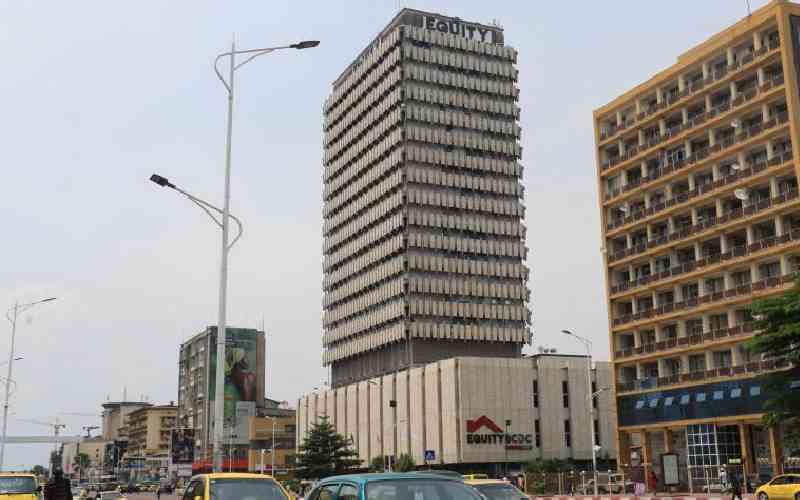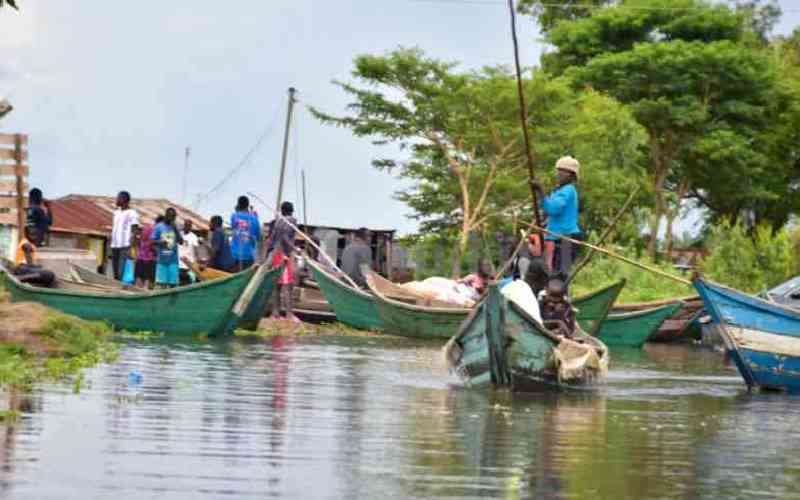
The sharp warning cry, “aluokra!”—Luo for “I’m bathing”—stopped me abruptly in my tracks. I had been drawn towards a vast sheet of backflow water sprawling some twenty metres across the grassy grazing fields. Though the flooding had brought water closer to livestock and people, it takes extraordinary courage for a woman to bathe openly in broad daylight in such a place.
Although the cry had halted my walk, my eyes kept roving. Further ahead, the backflow spread into shallow, stagnant water stretching expansively inland across the Usigu Sub-County peninsula in Siaya County and beyond.
Within the stagnant pools, an artisanal fisherman rowed his wooden boat, methodically checking his nets.
Nearby, unlike the shy woman shielding her privacy, a group of carefree children—boys and girls alike—splashed wildly and screamed with joy. They were stark naked, chasing each other through the water, utterly unbothered by its foul odour.
The fisherman’s nets yielded little: only a few weary tilapias.
The foul-smelling water is now turning greenish, yet herdsmen drive livestock to the pools.
“Good day!” one greeted me cheerfully, celebrating the heavy rains and backflow that had brought water closer to their grazing grounds, away from marauding crocodiles in the vast lake.
“My livestock are safe,” another quipped, though he admitted his wariness of the tiny green frogs sometimes lurking in the shallows—creatures harmless to people but poisonous to cattle if swallowed.
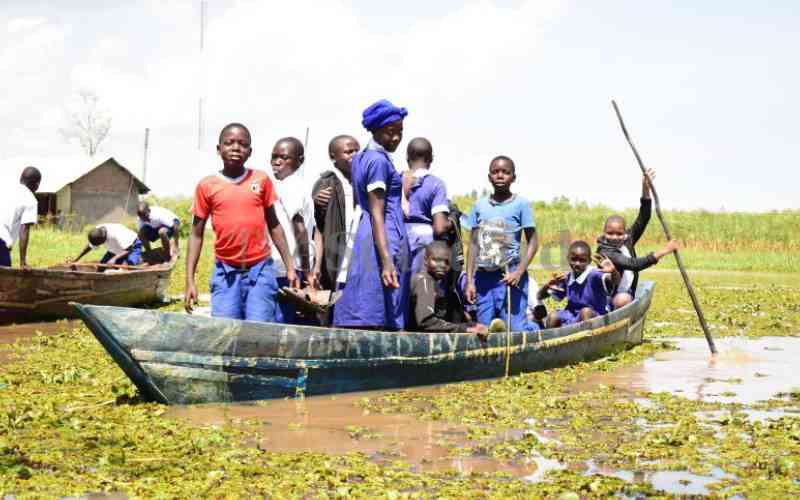
For the herders, the backflow was a mixed blessing. Rapid soil porosity had caused rainwater puddles elsewhere to vanish quickly, but here, lush grass endured. In sharp contrast to the lean, drought-stricken years when people and animals starved along the Lake Victoria basin, now there was abundance. Goats bleated, cows lowed, and sheep grazed peacefully, while their young—calves, kids and lambs—bounded playfully near the stagnant pools at Msoche Beach in Usigu.
Yet not everyone celebrated. Kisumu County’s Director for Climate Change, Evans Gichana, attributed the worsening backflow to intense rainfall driven by climate change. “We are witnessing risk factors unlike in the past. This is no ordinary floodwater,” he explained gravely.
READ: Lake Victoria backflow drowns hopes of fishermen, businesses
Environmental studies confirm his fears. Meteorological records show that convection patterns and precipitation trends around Lake Victoria are shifting. Thunderstorms generated over nearby mountains—Kilimanjaro to the east and the Rift Valley ranges to the west—are intensifying the deluges.
Poisoned water
Stay informed. Subscribe to our newsletter
Lake Victoria, Africa’s largest freshwater lake, already receives 80 per cent of its inflow from rainfall. In addition, 17 major rivers pour into its basin. Among them are the Yala, which runs 136 kilometres from the fertile Nandi Escarpment at a flow rate of 27.4 cubic metres per second, and the mighty Nzoia, winding 257 kilometres across seven counties before emptying its waters behind the historic Ramogi Hills.
These rivers not only bring life-giving water but also pollutants—fertilisers, pesticides, industrial waste, plastics, sewage and sediment.
Professor Leo Juma Ogalo, Dean of Agribusiness at Great Lakes University, was blunt: “The rivers ship in not just water but poisoned nutrients. They deposit litter, tyre remnants, pesticides, sewage, and agricultural impurities. The accumulation is staggering, and much of it ends up trapped in the stagnant backflows. This is environmental degradation at scale.”
He explained that agricultural fertilisers, pesticides, sewage, industrial waste, plastics and sediments gravely pollute Africa’s largest freshwater lake, leaving behind stagnant, toxic backflows.
“That back flow is a poisonous stagnant toxic sea ,” the Don adds.
The consequences are visible. Agriculturalist David Ombogo lamented that previous backflows destroyed farms, swept away crops and damaged critical infrastructure—roads, bridges and houses. “It worsens food insecurity. When farmlands drown, harvests vanish,” he said.
Subsistence farmer Carlos Mayende in Msoche agreed. “Too much water suffocates crops. Roots drown, nutrients cannot circulate, and leaves yellow before the plant collapses. It is death by excess.”
Indeed, much of the shoreline vegetation now lies wilted, forming what environmentalist George Owade called a “graveyard of biodiversity.”
Pointing at the waterlogged stretch, he said: “The ecosystem is collapsing. Livestock, wildlife and people are losing healthy grazing grounds and access to clean water. This is not life-giving water; it is toxic.”
Owade recalled with nostalgia the 1990s, when dhokulo shores yielded bountiful sweet potatoes before the backflow phenomenon became common. “Now, climate change has rewritten the script. What was once fertile land is turning barren,” he observed sadly.
The risks are not limited to agriculture. Stagnant backflow is a breeding ground for disease. Pools teem with malaria-spreading mosquitoes, while pathogens causing typhoid, cholera, dysentery and even poliomyelitis thrive in the murky water.
With only 21 per cent of Kenyans enjoying piped clean water and just 59 per cent accessing safe drinking water, many lakeside residents rely on these contaminated sources. Even bathing is hazardous: the water irritates skin and eyes, causes nausea, diarrhoea, and breathing problems.
Silent menace
Professor Ogalo warned of another silent menace—cyanobacteria and blue-green algae. These microscopic organisms flourish in warm, nutrient-rich stagnant water. They form discoloured mats and scums, releasing potent toxins.
“They sicken and can kill livestock, pets and aquatic animals. People too are not spared,” he cautioned.
The toxins attack the liver and nervous system. Fish die in large numbers, their bodies floating lifelessly on the swathe of green water. Owade, who monitors the shoreline, said: “Though dead fish may feed scavengers, I fear for the fate of molluscs, snails, crustaceans and mussels. The collapse of biodiversity is accelerating.”
He added grimly: “Much as water is life, this backflow water kills.”
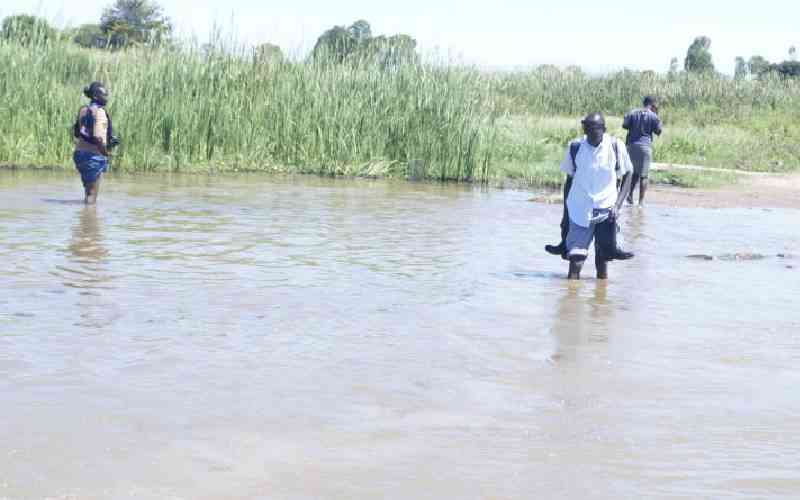
Yet amid the despair, scientists see faint hope. Under controlled laboratory conditions, invasive algae blooms and cyanobacteria can, paradoxically, support agriculture by improving seed germination under drought stress. “Every dark cloud has a silver lining,” Professor Ogalo noted, though he admitted the prospect of harnessing toxic blooms safely in the Lake Victoria basin remains distant.
ALSO READ: County seeks lasting solution to Lake Victoria backflow
Meanwhile, local communities continue to celebrate the convenience of the water, fetching it for livestock, cooking and bathing—largely unaware of its dangers. Children splash with abandon; herders drive cattle into the shallows. But the jubilant shouts mask an insidious truth: this stagnant backflow is not a blessing but a poisoned chalice.
Agriculturalist Ombogo put it bluntly: “The backflow is undermining the very foundations of life here. Crops die, livestock suffer, and people fall ill. Climate change has changed everything.”
From the high slopes of Kilimanjaro to the winding tributaries of the Nzoia, the chain of cause and effect converges on the shores of Lake Victoria. Climate change, deforestation, population pressure and industrial waste form a toxic cocktail now crystallised in the backflows.
What once were fertile shores now bear the appearance of a watery graveyard. The skeletal remains of vegetation protrude from the waterlogged earth, while invasive plants choke the sun from reaching below the surface. Domestic animals hesitate at the banks, sensing danger. Farmers stare helplessly at drowned fields.
The transformation is stark, the lesson undeniable. Humanity’s fractured relationship with nature has tipped into crisis.
The cry of “aluokra!” still echoes in my memory. That lone bather’s voice was more than a warning; it was an unwitting metaphor for an entire region’s vulnerability. The water that brings life now carries danger. And unless urgent action is taken, the backflow will remain a silent, expanding sea of death.


